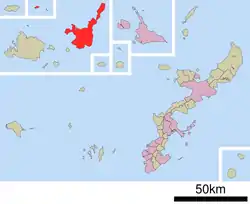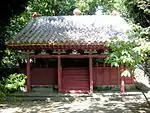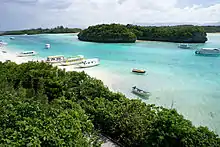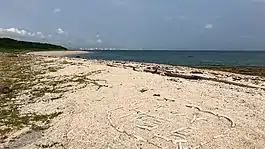Ishigaki
石垣市 Isïgaksï, Ishanagzï | |
|---|---|
 Top left: Mount Omoto, Top right: Mount Nosoko, 2nd row: Kabira Bay from Kabira Park, lower left: 730 Street in downtown Ishigaki, lower right: Shiraho natural reef, Bottom of left: Hirakubo peninsula from Tamatorizaki, Bottom right: Miyara old residence site | |
 Flag  Seal | |
 Location of Ishigaki in Okinawa Prefecture | |
 Ishigaki | |
| Coordinates: 24°20′26″N 124°9′20″E / 24.34056°N 124.15556°E | |
| Country | Japan |
| Region | Kyushu |
| Prefecture | Okinawa Prefecture |
| Government | |
| • Mayor | Yoshitaka Nakayama |
| Area | |
| • Total | 229.00 km2 (88.42 sq mi) |
| Population (October 1, 2016) | |
| • Total | 47,562 |
| • Density | 213/km2 (550/sq mi) |
| Time zone | UTC+9 (Japan Standard Time) |
| - Tree | Yaeyama kokutan (Diospyros ferrea) |
| - Flower | Sakishima tsutsuji (Rhododendron amanoi, Ohwi) |
| - Bird | Crested serpent eagle |
| - Butterfly | Rice paper butterfly |
| - Fish | Hamafuefuki (Lethrinus nebulosus) |
| - Shell | Black-lip oyster (Pinctada margaritifera) |
| Phone number | 0980-82-9911 |
| Address | 14 Misakichō, Ishigaki-shi 907-8501 |
| Climate | Af |
| Website | www |
Ishigaki (石垣市, Ishigaki-shi, Yaeyama: Isïgaksï, Ishanagzï) is a city in Okinawa Prefecture, Japan. It includes Ishigaki island and the Senkaku Islands territory.[1] The city is the political, cultural, and economic center of the Yaeyama Islands.[2] New Ishigaki Airport serves the city. As of December 2012, the city has an estimated population of 48,816 and a population density of 213 persons per km2. The total area is 229.00 km2.[3]
It is also the location of the Senkaku Islands (see below in the Geography section).
History
The current city of Ishigaki was founded in 1908 as Yaeyama Village, an amalgamation of the Ishigaki, Ōhama, and Miyara magiri. In 1914 it was renamed to Ishigaki Village, and grew to become Ishigaki Town in 1926. Ishigaki was elevated to city status on July 10, 1947.
Historical footnote: One of the first Frenchmen ever to visit Japan, Guillaume Courtet, came ashore at Ishigaki in 1636.
Geography
The city of Ishigaki covers the entirety of Ishigaki Island (222 km2 (86 sq mi)).[4] The island is surrounded by coral reefs. The highest point on Ishigaki Island is Omotodake (525.5 m (1,724 ft)).[5]
The uninhabited Senkaku Islands are located 150 km (93 mi) north of the Ishigaki Island. The Senkaku Islands cover roughly 6.3 km2 (2.4 sq mi).[6][7]
Economy
Ishigaki produces sugarcane and pineapples. Tourism is also an important part of the economy of the city.[2]
Transportation
New Ishigaki Airport and Ishigaki Port serve the city.
Climate
Ishigaki has a tropical rainforest climate (Köppen climate classification Af) with frequent cyclones so not equatorial. "Summers" are hot and "winters" warm. Precipitation is abundant throughout the year; the rainiest months are August and September (due to tropical storm/typhoon) while the driest months are December and July.
| Climate data for Ishigaki (1991−2020 normals, extremes 1896−present) | |||||||||||||
|---|---|---|---|---|---|---|---|---|---|---|---|---|---|
| Month | Jan | Feb | Mar | Apr | May | Jun | Jul | Aug | Sep | Oct | Nov | Dec | Year |
| Record high °C (°F) | 27.8 (82.0) |
29.1 (84.4) |
29.4 (84.9) |
32.9 (91.2) |
33.7 (92.7) |
34.6 (94.3) |
35.3 (95.5) |
35.6 (96.1) |
35.4 (95.7) |
33.2 (91.8) |
30.9 (87.6) |
29.0 (84.2) |
35.6 (96.1) |
| Mean daily maximum °C (°F) | 21.5 (70.7) |
22.0 (71.6) |
23.7 (74.7) |
26.0 (78.8) |
28.7 (83.7) |
30.9 (87.6) |
32.2 (90.0) |
32.0 (89.6) |
31.0 (87.8) |
28.8 (83.8) |
26.2 (79.2) |
23.0 (73.4) |
27.2 (81.0) |
| Daily mean °C (°F) | 18.9 (66.0) |
19.4 (66.9) |
20.9 (69.6) |
23.4 (74.1) |
25.9 (78.6) |
28.4 (83.1) |
29.6 (85.3) |
29.4 (84.9) |
28.2 (82.8) |
26.0 (78.8) |
23.6 (74.5) |
20.5 (68.9) |
24.5 (76.1) |
| Mean daily minimum °C (°F) | 16.7 (62.1) |
17.2 (63.0) |
18.6 (65.5) |
21.3 (70.3) |
23.9 (75.0) |
26.6 (79.9) |
27.7 (81.9) |
27.3 (81.1) |
26.0 (78.8) |
23.9 (75.0) |
21.5 (70.7) |
18.4 (65.1) |
22.4 (72.3) |
| Record low °C (°F) | 6.0 (42.8) |
5.9 (42.6) |
7.2 (45.0) |
10.0 (50.0) |
11.2 (52.2) |
16.5 (61.7) |
20.0 (68.0) |
17.4 (63.3) |
17.2 (63.0) |
14.0 (57.2) |
7.1 (44.8) |
6.6 (43.9) |
5.9 (42.6) |
| Average precipitation mm (inches) | 135.0 (5.31) |
124.0 (4.88) |
134.4 (5.29) |
146.9 (5.78) |
190.7 (7.51) |
208.2 (8.20) |
142.3 (5.60) |
249.8 (9.83) |
259.7 (10.22) |
211.2 (8.31) |
138.1 (5.44) |
155.2 (6.11) |
2,095.5 (82.50) |
| Average precipitation days (≥ 0.5 mm) | 14.9 | 11.7 | 11.7 | 10.3 | 11.1 | 10.0 | 10.4 | 13.3 | 13.1 | 12.3 | 12.8 | 14.8 | 146.3 |
| Average relative humidity (%) | 72 | 73 | 74 | 77 | 79 | 81 | 77 | 78 | 76 | 73 | 73 | 71 | 75 |
| Mean monthly sunshine hours | 84.7 | 91.3 | 118.1 | 130.3 | 164.3 | 212.9 | 261.0 | 232.9 | 189.9 | 157.6 | 115.3 | 89.3 | 1,852.5 |
| Source: Japan Meteorological Agency[8] | |||||||||||||
Sights
The town of Ishigaki has various sights to offer.
- Gongen Do is a Shinto shrine close to the center of Ishigaki town which was founded in 1614. The shrine was destroyed during a flood in 1771. The present buildings date from 1787.[9] The neighbouring building is Torin Ji, a buddhist temple which was founded in 1614 as well. It houses several statues dating from 1737 which possibly represent tutelary gods of Ishigaki Island.
- Close by is Miyaradunchi, a residential building dating from 1819. Its architecture with a hip roof consisting of red tiles is similar to samurai houses on mainland Japan, but there have never been samurai on the Yaeyama Islands.
- The Museum of the Yaeyama Islands, Shiritsu Yaeyama Hakubutsukan, is on Main Street in the center of Ishigaki town. Various kinds of boats and other items referring to the history and culture of the Yaeyama Islands can be seen. It is famous for being the southernmost museum of Japan.
- Fuzaki Kannon Do is a small Shinto shrine dating from 1742. It is 5 km (3.1 mi) west of the town on a hill offering a scenic view of Ishigaki and Iriomote, the neighbouring island.[10] The shrine is dedicated to Kannon.
- Tojinbaka is tomb in a typical Chinese style about 6 km (3.7 mi) west the town on the ring road. 400 Chinese labourers who died during a rebellion on a ship sailing to America in 1852 are buried here.[11]
- Kabira Bay
 Shinyakusho-Dori
Shinyakusho-Dori Shinto shrine Gongen Do
Shinto shrine Gongen Do Torin Ji Temple
Torin Ji Temple Miyara Donchi
Miyara Donchi Catholic Church in Ishigaki
Catholic Church in Ishigaki Shrine Fuzaki Kannon Do
Shrine Fuzaki Kannon Do Tojinbaka Tomb
Tojinbaka Tomb Kabira Bay
Kabira Bay.jpg.webp) Ishigaki Port
Ishigaki Port Ishigaki viewed from Taketomi
Ishigaki viewed from Taketomi
Notable people from Ishigaki
- Yukiya Arashiro (born 1984) professional cyclist
- Yudai Arashiro (born 1995) professional cyclist
- Yōkō Gushiken (born 1955) boxer
- Rimi Natsukawa (born 1973) folk singer
- Begin (band) (all members born 1968) pop musical group
- Kaima Taira (born 1999) professional baseball pitcher
Sister cities
In Japan
Overseas
- Su'ao, Taiwan
- Kauai County, Hawaii, United States
References
- ↑ "石垣(市)" [Ishigaki]. Nihon Daihyakka Zensho (Nipponika) (in Japanese). Tokyo: Shogakukan. 2012. OCLC 153301537. Archived from the original on 2007-08-25. Retrieved 2012-12-14.
- 1 2 "Ishigaki". Encyclopedia of Japan. Tokyo: Shogakukan. 2012. OCLC 56431036. Archived from the original on 2007-08-25. Retrieved 2012-12-31.
- ↑ 石垣市の人口 [Population of Ishigaki] (in Japanese). Ishigaki, Okinawa Prefecture, Japan: City of Ishigaki. 2013. Archived from the original on 2013-01-31. Retrieved 2013-01-28.
- ↑ "平成27年全国都道府県市区町村別面積調 島面積" (PDF). Geospatial Information Authority of Japan. 2015-10-01. p. 111. Archived from the original (PDF) on 2016-06-15. Retrieved 2016-04-15.
- ↑ "Ishigakijima". Encyclopedia of Japan. Tokyo: Shogakukan. 2012. OCLC 56431036. Archived from the original on 2007-08-25. Retrieved 2012-12-14.
- ↑ "Senkaku". Encyclopedia of Japan. Tokyo: Shogakukan. 2012. OCLC 56431036. Archived from the original on 2007-08-25. Retrieved 2012-12-14.
- ↑ "尖閣諸島" [Senkaku Islands]. Nihon Rekishi Chimei Taikei (in Japanese). Tokyo: Shogakukan. 2012. OCLC 173191044. dlc 2009238904. Archived from the original on 2007-08-25. Retrieved 2012-12-07.
- ↑ 気象庁 / 平年値(年・月ごとの値). Japan Meteorological Agency. Retrieved May 19, 2021.
- ↑ Chris Taylor: Japan, S. 716. Stefan Loose Verlag. Berlin 1998
- ↑ Yamakei: Ryukyu Nansei Shoto, p.106. Tokio 2003. ISBN 4-635-01718-4
- ↑ Yamakei: Ryukyu Nansei Shoto, p.105. Tokio 2003. ISBN 4-635-01718-4
External links
- Official website
 Geographic data related to Ishigaki, Okinawa at OpenStreetMap
Geographic data related to Ishigaki, Okinawa at OpenStreetMap